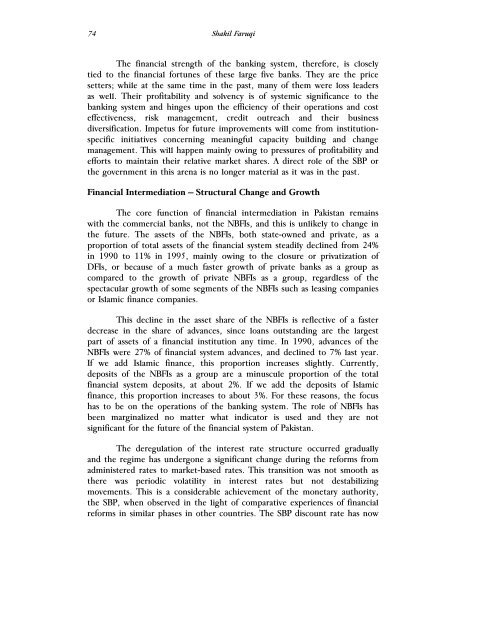Special Edition-07.pdf - Lahore School of Economics
Special Edition-07.pdf - Lahore School of Economics
Special Edition-07.pdf - Lahore School of Economics
Create successful ePaper yourself
Turn your PDF publications into a flip-book with our unique Google optimized e-Paper software.
74<br />
Shakil Faruqi<br />
The financial strength <strong>of</strong> the banking system, therefore, is closely<br />
tied to the financial fortunes <strong>of</strong> these large five banks. They are the price<br />
setters; while at the same time in the past, many <strong>of</strong> them were loss leaders<br />
as well. Their pr<strong>of</strong>itability and solvency is <strong>of</strong> systemic significance to the<br />
banking system and hinges upon the efficiency <strong>of</strong> their operations and cost<br />
effectiveness, risk management, credit outreach and their business<br />
diversification. Impetus for future improvements will come from institutionspecific<br />
initiatives concerning meaningful capacity building and change<br />
management. This will happen mainly owing to pressures <strong>of</strong> pr<strong>of</strong>itability and<br />
efforts to maintain their relative market shares. A direct role <strong>of</strong> the SBP or<br />
the government in this arena is no longer material as it was in the past.<br />
Financial Intermediation – Structural Change and Growth<br />
The core function <strong>of</strong> financial intermediation in Pakistan remains<br />
with the commercial banks, not the NBFIs, and this is unlikely to change in<br />
the future. The assets <strong>of</strong> the NBFIs, both state-owned and private, as a<br />
proportion <strong>of</strong> total assets <strong>of</strong> the financial system steadily declined from 24%<br />
in 1990 to 11% in 1995, mainly owing to the closure or privatization <strong>of</strong><br />
DFIs, or because <strong>of</strong> a much faster growth <strong>of</strong> private banks as a group as<br />
compared to the growth <strong>of</strong> private NBFIs as a group, regardless <strong>of</strong> the<br />
spectacular growth <strong>of</strong> some segments <strong>of</strong> the NBFIs such as leasing companies<br />
or Islamic finance companies.<br />
This decline in the asset share <strong>of</strong> the NBFIs is reflective <strong>of</strong> a faster<br />
decrease in the share <strong>of</strong> advances, since loans outstanding are the largest<br />
part <strong>of</strong> assets <strong>of</strong> a financial institution any time. In 1990, advances <strong>of</strong> the<br />
NBFIs were 27% <strong>of</strong> financial system advances, and declined to 7% last year.<br />
If we add Islamic finance, this proportion increases slightly. Currently,<br />
deposits <strong>of</strong> the NBFIs as a group are a minuscule proportion <strong>of</strong> the total<br />
financial system deposits, at about 2%. If we add the deposits <strong>of</strong> Islamic<br />
finance, this proportion increases to about 3%. For these reasons, the focus<br />
has to be on the operations <strong>of</strong> the banking system. The role <strong>of</strong> NBFIs has<br />
been marginalized no matter what indicator is used and they are not<br />
significant for the future <strong>of</strong> the financial system <strong>of</strong> Pakistan.<br />
The deregulation <strong>of</strong> the interest rate structure occurred gradually<br />
and the regime has undergone a significant change during the reforms from<br />
administered rates to market-based rates. This transition was not smooth as<br />
there was periodic volatility in interest rates but not destabilizing<br />
movements. This is a considerable achievement <strong>of</strong> the monetary authority,<br />
the SBP, when observed in the light <strong>of</strong> comparative experiences <strong>of</strong> financial<br />
reforms in similar phases in other countries. The SBP discount rate has now

















